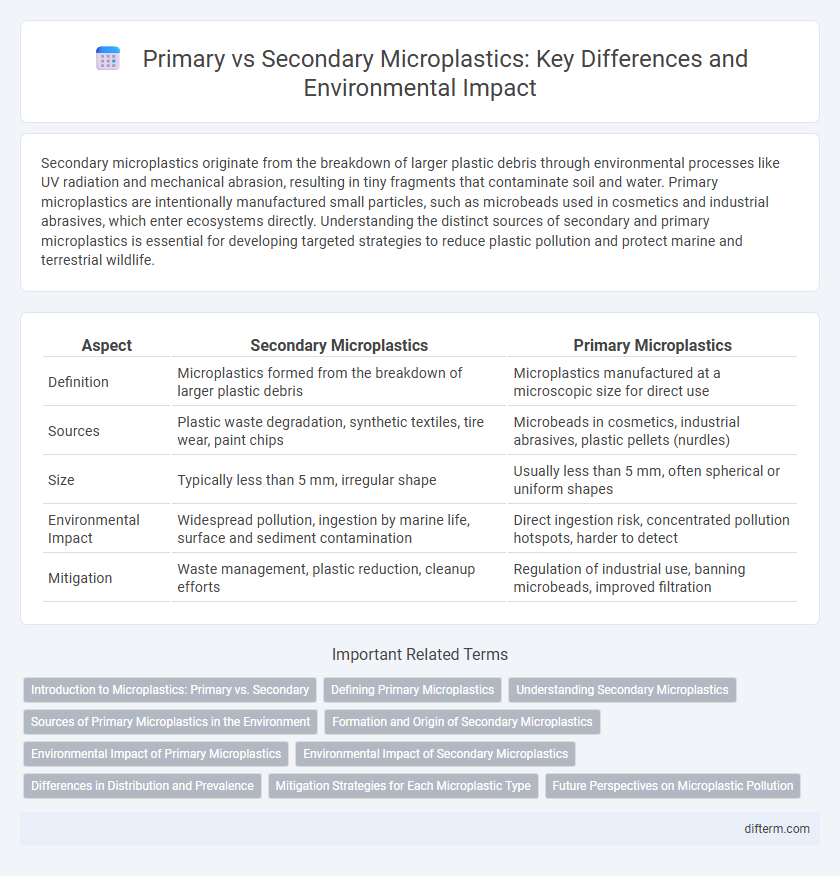Secondary microplastics originate from the breakdown of larger plastic debris through environmental processes like UV radiation and mechanical abrasion, resulting in tiny fragments that contaminate soil and water. Primary microplastics are intentionally manufactured small particles, such as microbeads used in cosmetics and industrial abrasives, which enter ecosystems directly. Understanding the distinct sources of secondary and primary microplastics is essential for developing targeted strategies to reduce plastic pollution and protect marine and terrestrial wildlife.
Table of Comparison
| Aspect | Secondary Microplastics | Primary Microplastics |
|---|---|---|
| Definition | Microplastics formed from the breakdown of larger plastic debris | Microplastics manufactured at a microscopic size for direct use |
| Sources | Plastic waste degradation, synthetic textiles, tire wear, paint chips | Microbeads in cosmetics, industrial abrasives, plastic pellets (nurdles) |
| Size | Typically less than 5 mm, irregular shape | Usually less than 5 mm, often spherical or uniform shapes |
| Environmental Impact | Widespread pollution, ingestion by marine life, surface and sediment contamination | Direct ingestion risk, concentrated pollution hotspots, harder to detect |
| Mitigation | Waste management, plastic reduction, cleanup efforts | Regulation of industrial use, banning microbeads, improved filtration |
Introduction to Microplastics: Primary vs. Secondary
Primary microplastics are intentionally manufactured small plastic particles, such as microbeads used in cosmetics and industrial abrasives, designed to be microscopic from the outset. Secondary microplastics result from the fragmentation of larger plastic debris due to environmental weathering, UV radiation, and mechanical abrasion, leading to widespread dissemination in marine and terrestrial ecosystems. Understanding the distinction between these sources is critical for targeting pollution reduction strategies and mitigating the pervasive environmental impact of plastic contaminants.
Defining Primary Microplastics
Primary microplastics are tiny plastic particles manufactured to be microscopic in size, commonly found in personal care products, industrial abrasives, and plastic pellets used in manufacturing processes. These particles typically measure less than 5 millimeters and enter the environment directly without undergoing degradation. Unlike secondary microplastics, which result from the breakdown of larger plastic debris, primary microplastics pose significant challenges due to their widespread use and direct release into aquatic ecosystems.
Understanding Secondary Microplastics
Secondary microplastics originate from the degradation of larger plastic debris through physical, chemical, and biological processes, contributing significantly to environmental pollution. These particles often result from the fragmentation of items such as plastic bags, bottles, and fishing nets, increasing their prevalence in marine and terrestrial ecosystems. Understanding the formation and impact of secondary microplastics is crucial for developing effective mitigation strategies and reducing their adverse effects on wildlife and human health.
Sources of Primary Microplastics in the Environment
Primary microplastics originate directly from products such as microbeads in cosmetics, synthetic fibers from clothing during washing, and industrial abrasives used in sandblasting. These tiny plastic particles enter waterways and soils through wastewater discharge and runoff, contributing significantly to environmental pollution. Understanding and reducing these sources is crucial for mitigating microplastic contamination in aquatic and terrestrial ecosystems.
Formation and Origin of Secondary Microplastics
Secondary microplastics form from the gradual breakdown of larger plastic debris through environmental factors such as UV radiation, mechanical abrasion, and chemical degradation. Their origin traces back to everyday plastic products, including packaging, fishing nets, and synthetic textiles that fragment over time. These particles are pervasive in marine and terrestrial ecosystems, contributing significantly to microplastic pollution and posing threats to wildlife and human health.
Environmental Impact of Primary Microplastics
Primary microplastics, which originate from manufactured products such as microbeads in cosmetics and industrial abrasives, pose significant threats to marine ecosystems due to their small size and persistent nature. These particles are readily ingested by aquatic organisms, leading to physical harm, toxic chemical exposure, and disruption of food webs. Unlike secondary microplastics, which result from the breakdown of larger plastics, primary microplastics introduce novel pollution that directly enters the environment, complicating mitigation efforts.
Environmental Impact of Secondary Microplastics
Secondary microplastics originate from the breakdown of larger plastic debris due to environmental factors such as UV radiation, mechanical forces, and biodegradation, resulting in widespread contamination across marine and terrestrial ecosystems. Their smaller size increases bioavailability to aquatic organisms, leading to ingestion, bioaccumulation, and potential disruption of food webs. These particles also act as vectors for persistent organic pollutants and heavy metals, exacerbating toxicity and long-term environmental harm.
Differences in Distribution and Prevalence
Secondary microplastics originate from the fragmentation of larger plastic debris, resulting in widespread distribution primarily near coastlines and urban runoff areas. In contrast, primary microplastics, manufactured at microscopic sizes such as microbeads in personal care products, tend to be prevalent in wastewater effluents and freshwater bodies. The environmental prevalence of secondary microplastics is significantly higher due to the extensive breakdown of macroplastics, while primary microplastics represent a continuous source from specific industrial and consumer activities.
Mitigation Strategies for Each Microplastic Type
Mitigation strategies for primary microplastics focus on preventing their release at the source by regulating industrial practices and promoting alternatives to plastic microbeads in cosmetics and personal care products. Secondary microplastic mitigation emphasizes reducing plastic waste degradation through enhanced waste management systems, increased recycling rates, and environmental cleanup initiatives to prevent fragmentation of larger plastics. Both approaches benefit from public education campaigns and policy enforcement to minimize overall microplastic pollution in aquatic and terrestrial ecosystems.
Future Perspectives on Microplastic Pollution
Emerging research on microplastic pollution emphasizes the increasing prevalence of secondary microplastics, originating from the degradation of larger plastic debris, surpassing primary microplastics produced directly for commercial use. Advances in detection technologies and biodegradable materials aim to mitigate fragmentation processes, but the persistence of secondary microplastics in marine and terrestrial ecosystems remains a significant environmental challenge. Future strategies prioritize enhancing waste management systems and promoting circular economy models to reduce plastic waste inputs and limit secondary microplastic formation.
secondary microplastics vs primary microplastics Infographic

 difterm.com
difterm.com